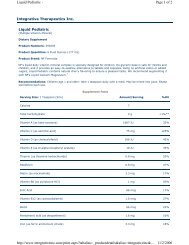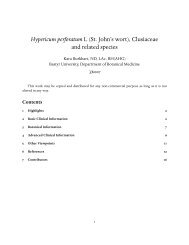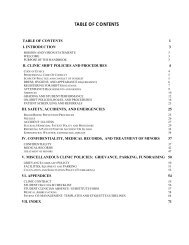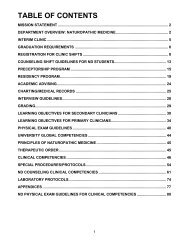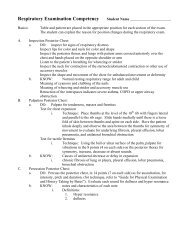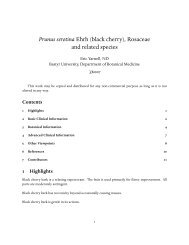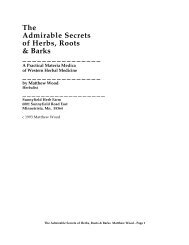Cinchona officinalis L (Peruvian bark), Rubiaceae ... - AaronsWorld
Cinchona officinalis L (Peruvian bark), Rubiaceae ... - AaronsWorld
Cinchona officinalis L (Peruvian bark), Rubiaceae ... - AaronsWorld
Create successful ePaper yourself
Turn your PDF publications into a flip-book with our unique Google optimized e-Paper software.
percolation, as explained under Tincturae, and make 20 fluid ounces of tincture. This tincture is<br />
generally known as Huxham’s tincture of <strong>bark</strong>. Prof. King preferred brandy as the menstruum.<br />
TINCTURA ANTIPERIODICA (N. F.), Antiperiodic tincture, Warburg’s tincture.—I. Without<br />
aloes. Rhubarb, thirty-six grammes (36 Gm.) [1 oz. av., 118 grs.]; angelica seed, thirty-six grammes<br />
(36 Gm.) [1 oz. av., 118 grs]; elecampane, eighteen grammes (18 Gm.) [278 grs.]; saffron, eighteen<br />
grammes (18 Gm.) [278 grs.]; fennel, eighteen grammes (18 Gm.) [278 grs.]; gentian, nine grammes<br />
(9 Gm.) [139 grs.]; zedoary root, nine grammes (9 Gm.) [139 grs.]; cubeb, nine grammes (9 Gm.)<br />
[139 grs.]; myrrh, nine grammes (9 Gm.) [139 grs.]; white agaric, nine grammes (9 Gm.) [139 grs.];<br />
camphor, nine grammes (9 Gm.) [139 grs.]; quinine sulphate, one hundred grammes (100 Gm.) [3 ozs.<br />
av., 231 grs.]; diluted alcohol (U. S. P.), a sufficient quantity to make five thousand cubic centimeters<br />
(5000 Cc.) [169 fl, 33]. Reduce the fibrous vegetable drugs to a coarse (No. 20) powder, mix this with<br />
the myrrh and camphor, previously powdered, and digest the whole, during 12 hours, in a suitable,<br />
well-covered vessel, with forty-two hundred and fifty cubic centimeters (4250 Cc.) [143 fl, 140] of diluted<br />
alcohol, on a water-bath, avoiding, as much as possible, any loss of alcohol by evaporation. Then<br />
strain off the liquid with pressure, dissolve the quinine sulphate in the strained liquid, with a gentle<br />
heat, if necessary, filter, and pass enough diluted alcohol, first through the strainer and then through<br />
the filter to make the product measure five thousand cubic centimeters (5000 Cc.) [169 fl, 33]. Each<br />
fluid ounce contains 10 grains of quinine sulphate. Note.—This preparation, made without aloes, is<br />
intended to serve as a stock tincture, from which the regular ’Warburg’s Tincture’ is to be made, when<br />
required. ’Warburg’s Tincture without Aloes’ is also often prescribed or asked for, and in this case the<br />
above preparation is to be dispensed. The original formula directed by Dr. Warburg, contained the<br />
old Confectio Damocratis as one of the ingredients. The latter is a very complex preparation, many<br />
of the constituents being unobtainable at the present day. It has, therefore, been omitted. II. With<br />
aloes.—Extract of aloes (U. S. P.), seventeen and one-half grammes (17.5 Gm.) [270 grs.]; antiperiodic<br />
tincture, without aloes, one thousand cubic centimeters (1000 Cc.) [33 fl, 391]. Dissolve the extract<br />
in the tincture. Note.—When ’Warburg’s Tincture, without any further specification, is ordered, this<br />
preparation (containing aloes) is to be dispensed”—(Nat. Form.).<br />
5 Other Viewpoints<br />
5.1 Discussions in Historical Texts<br />
A Modern Herbal by M. Grieve<br />
<strong>Peruvian</strong> <strong>bark</strong> was introduced to Europe in 1640, but the plant producing it was not known to botanists<br />
till 1737; a few years later it was renamed <strong>Cinchona</strong> after the Countess of Chinchon, who first made the<br />
<strong>bark</strong> known in Europe for its medicinal qualities. The history of <strong>Cinchona</strong> and its many vicissitudes<br />
affords a striking illustration of the importance of Government aid in establishing such an industry. It<br />
was known and used by the Jesuits very early in its history, but was first advertized for sale in England<br />
by James Thompson in 1658, and was made official in the London Pharmacopoeia of 1677.<br />
10



